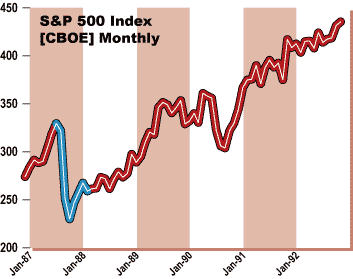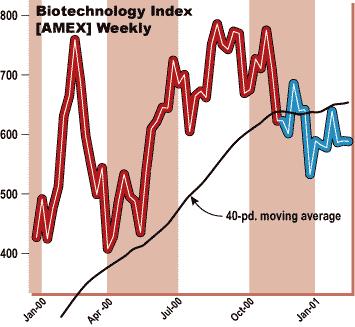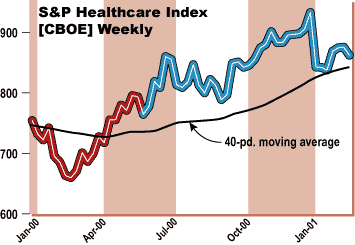
HOT TOPICS LIST
- Strategies
- Stocks
- Buy
- Investing
- Brokers
- Psychology
- Interviews
- Accumulate
- Sell
- Hold
- Spotlight
- Websites
- Candlestick Corner
- Gold & Metals
- Options Trading
LIST OF TOPICS
MONEY MANAGEMENT
Jump In! Jump Out! Using Market Timing
03/26/01 11:41:04 PM PSTby RM Sidewitz, Ph.D
Buy-and-hold notwithstanding, all investors want to be in when markets are rising and out when markets are falling. Even the simplest market timing strategies can help you do just that.
| There have been 15 bear markets since 1929, and on average, they have chopped 35.1% off the Standard & Poor's 500 index. This means that if you had used a buy-and-hold strategy during this period, it would have taken years to recoup the loss. Look at the bear market that took place in 1987 (Figure 1). It wasn't until 1991 that the market finally stabilized and resumed its upward trend. A buy-and-hold strategy sounds great. Why wouldn't it? The concept seems ideal: buying stocks of solid companies that promise future growth or investing in top-rated mutual funds without having to worry about their performance on a regular basis. But buy-and-hold can eventually end up in a devastating failure. Buy-and-hold is actually an archaic timing strategy, the rules for which are:
Most investors can handle relatively small losses. For many, however, their viewpoint will shift as their losses mount, especially as they rise past the 15% level. As your losses get bigger, your fear of further losses grows exponentially. Eventually, this leads you to finally sell, with the hope that things will be different the next time you venture into the fray.
In addition, buy-and-hold investing becomes dangerous when you need access to your investment capital relatively quickly, whether to buy a new home or for retirement purposes. Think about it. Suppose you have designed an investment plan such that you need to have the capital for whatever reason in 10 years. Suppose the market suffered a severe setback in that 10th and final year. The market correction and the ensuing bear market could wipe out one-third or more of your portfolio, preventing you from reaching your goal of buying a house or retiring. This would mean you would have to wait for an even longer time before having the capital you need.
Market timing strategies don't have to be difficult to grasp. If you aren't comfortable employing such a strategy on your own, there are professional money managers who utilize market-timing systems. Most systems work well in reducing market risk, and some outperform the market averages. Even a simple 40-period moving average has worked effectively over the years. For example, Figure 2 shows a weekly chart of the American Stock Exchange (Amex) biotechnology index with a 40-period moving average overlay. When prices fall below the moving average, you should consider moving investments out of this sector and into the health-care sector (Figure 3). The S&P health-care index is still above its 40-period moving average.
Market timing should definitely serve as a foundation to all your money management strategies. It can help you reduce losses during bear markets and improve the overall performance of your portfolio. R.M. Sidewitz is chief executive officer and founder of Qi2 Technologies, LLC, an investment management company, and the managing member of Qi2 Partners LP, a domestic hedge fund. For additional information on long-term investing, go to www.longterminvestor.org. |
Dr. Sidewitz is the President, Chief Executive Officer and founder of Qi2 Technologies, LLC, an investment management company and the Managing Member of Qi2 Partners LP, a domestic hedge fund. Dr. Sidewitz began his career on Wall Street in the mid-1960s with Moody's Investors Service. He then served as the Assistant Director of Research for a registered broker/dealer until 1971. In the ensuing years, he continued his pursuits as a private investor during which time he developed the proprietary methodology that is used by the Limited Partnership. Dr. Sidewitz is the author of two books, "How I Double My Money Annually in the Market" and "How to Stop Sabotaging Your Trading Success: Mastering the Inner Realm". He is a frequent contributor to numerous financial publications and continues to work closely with private clients.
| Title: | Managing Partner |
| Company: | Qi2 Technologies LLC |
| Address: | 4800 Baseline Road, Suites E104-370 |
| Boulder, CO 80303 | |
| Website: | www.cybrlink.com |
| E-mail address: | roy@cybrlink.com |
Traders' Resource Links | |
PRINT THIS ARTICLE

|

Request Information From Our Sponsors
- StockCharts.com, Inc.
- Candle Patterns
- Candlestick Charting Explained
- Intermarket Technical Analysis
- John Murphy on Chart Analysis
- John Murphy's Chart Pattern Recognition
- John Murphy's Market Message
- MurphyExplainsMarketAnalysis-Intermarket Analysis
- MurphyExplainsMarketAnalysis-Visual Analysis
- StockCharts.com
- Technical Analysis of the Financial Markets
- The Visual Investor
- VectorVest, Inc.
- Executive Premier Workshop
- One-Day Options Course
- OptionsPro
- Retirement Income Workshop
- Sure-Fire Trading Systems (VectorVest, Inc.)
- Trading as a Business Workshop
- VectorVest 7 EOD
- VectorVest 7 RealTime/IntraDay
- VectorVest AutoTester
- VectorVest Educational Services
- VectorVest OnLine
- VectorVest Options Analyzer
- VectorVest ProGraphics v6.0
- VectorVest ProTrader 7
- VectorVest RealTime Derby Tool
- VectorVest Simulator
- VectorVest Variator
- VectorVest Watchdog



